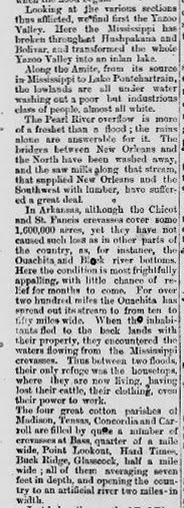 |
| Mississippi River Flooding of 1874 |
The above map shows the entire area of flooding in the Mississippi Valley in 1874.
Below is a zoomed in portion of the Mississippi Valley which shows Catahoula Parish and the flooding which occurred in the northern and southeastern sections of the parish.
 |
| Flooded Portions of Catahoula Parish in 1874 |
News reports of the 1874 Mississippi River flood began as early as February 21 as seen in this article from the Highland Weekly out of Hillsboro, North Carolina.
 |
| Highland Weekly - 2/21/1874 |
The following notice by the Office of Commission of Engineers appeared in the March 21, 1874 edition of the Donaldsonville Chief:
 |
| Donaldsonville Chief - 3/21/1874 |
From an article appearing in the Ouachita Telegraph in Monroe on May 1, 1874:
 |
| Ouachita Telegraph - 5/1/1874 |
At a mass meeting of the citizens of the parish of Catahoula, La., assembled at Trinity, La., on the 15th April, 1874, for the purpose of taking into consideration the wretched and deplorable state of affairs existing on Ouachita, Black, Tensas and Little rivers, and the lands contiguous thereto, caused by the unprecendented and ruinous high waters which are now overflowing the whole country, and subjecting the citizens to near starvation, it was
Resolved, That it is a solemn and sad fact that the extreme high water which now covers our entire rich alluvial lands, is bringing with it great distress among the people, who have no money, no credit, and not more than ten days rations. This want of money and provisions in this district, arises from the fact that crops were almost a total failure last year; the people are in debt, and no one will advance them money, credit or provisions.
Resolved, That it is a fact, that the few mules and cattle now remaining in the overflowed district, on a few small ridges of land, are poor and starving for want of provender, and the people are in no better situation.
Be it further resolved, That the Governor of the State, and the President of the United States, be notified of and made acquainted with the hunger, destitution and want of this section of country, and that they be requested to furnish the poor, destitute people of the district with meat, meal and corn.
On April 18, 1874, the New Orleans Republican printed correspondence between General W. H. Emory, a committee, Governor William P. Kellogg, New Orleans Mayor Wiltz and President Ulysses S. Grant. This correspondence began with a committee's appeal to General Emory for relief for sufferers in North Louisiana which included Catahoula Parish.
Dear Sir: We respectfully request your favorable endorsement of the foregoing printed resolutions and accompanying statement of facts relative to the sufferers in the overflowed districts, in the parishes of Ouachita, Richland, Franklin, Caldwell and Catahoula, and respectfully ask that you solicit the War Department to furnish 50,000 rations to the sufferers from the overflow immediately.
 |
| Part One |
 |
| Part Two |
 |
| Part Three |
 |
| Part Four |
 |
| Part Five - New Orleans Republican - 4/18/1874 |
Several days later an article appeared in the Wheeling Daily Intelligencer out of Wheeling, West Virginia. The article reports that no supplies were able to be spared from military stations in the region. Therefore, the Secretary of War instructed the Commissary Subsistance to purchase rations for an estimated 20,000 persons for twenty-five days.
 |
| Wheeling Daily Intelligencer - 4/27/1874 |
The following article appeared in the May 16, 1874 edition of The Caucasian out of Shreveport, Louisiana. The extent and consequences of the Mississippi River flood are described in detail. In summary, the article states:
To sum up the flood from Memphis to the Passes, the crevases are fifty miles in width. Through them flow streams greater and more powerful than the mighty Mississippi itself, and which pour out on this devoted country 2,000,000,000 cubic feet of water every hour. Not only is this water thrown on the land, but it must find its way to the sea through six hundred miles of low alluvial lands. It is not hyperbole, then, to say that the Mississippi is wider now than the far-famed Amazon, whose mouth is two hundred and fifty miles in width.
 |
| Part One |
 |
| Part Two |
 |
| Part Three |
 |
| Part Four - The Caucasian - 5/16/1874 |
*This post is part one in a series of posts in which an attempt will be made to document the history of flooding in Catahoula Parish caused by the overflow of the Mighty Mississippi River. Occurrences will be presented using maps, newspaper articles, photographs and reports from the State Library of Louisiana and other collections from the sources linked below each post.
Sources:
loc.gov
chroniclingamerica.loc.gov
















No comments:
Post a Comment